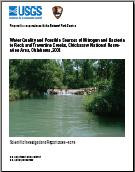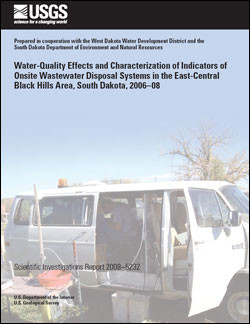
Product Details
- Product Number
- 313781
- Series
- SIR-2011-5150
- Scale
- NO SCALE
- Alternate ID
- SIR-2011-5150
- ISBN
- 978-1-4113-3265-2
- Authors
- TERRY M GELLNER
- Version Date
- 01/01/2011
- Regions
- OH
- Countries
- USA
- Media
- Paper
- Format
- Bound
Additional Details
- Description
- Abstract Membrane bioreactors (MBR), used for wastewater treatment in Ohio and elsewhere in the United States, have pore sizes small enough to theoretically reduce concentrations of protozoa and bacteria, but not viruses. Sampling for viruses in wastewater is seldom done and not required. Instead, the bacterial indicators Escherichia coli (E. coli) and fecal coliforms are the required microbial measures of effluents for wastewater-discharge permits. Information is needed on the effectiveness of MBRs in removing human enteric viruses from wastewaters, particularly as compared to conventional wastewater treatment before and after disinfection. A total of 73 regular and 28 quality-control (QC) samples were collected at three MBR and two conventional wastewater plants in Ohio during 23 regular and 3 QC sampling trips in 2008–10. Samples were collected at various stages in the treatment processes and analyzed for bacterial indicators E. coli, fecal coliforms, and enterococci by membrane filtration; somatic and F-specific coliphage by the single agar layer (SAL) method; adenovirus, enterovirus, norovirus GI and GII, rotavirus, and hepatitis A virus by molecular methods; and viruses by cell culture. While addressing the main objective of the study—comparing removal of viruses and bacterial indicators in MBR and conventional plants—it was realized that work was needed to identify data analysis and quantification methods for interpreting enteric virus and QC data. Therefore, methods for quantifying viruses, qualifying results, and applying QC data to interpretations are described in this report. During each regular sampling trip, samples were collected (1) before conventional or MBR treatment (post-preliminary), (2) after secondary or MBR treatment (post-secondary or post-MBR), (3) after tertiary treatment (one conventional plant only), and (4) after disinfection (post-disinfection). Glass-wool fiber filtration was used to concentrate enteric viruses from large volumes, and small volume grab samples were collected for direct-plating analyses for bacterial indicators and coliphage. After filtration, the viruses were eluted from the filter and further concentrated. The final concentrated sample volume (FCSV) was used for enteric virus analysis by use of two methods—cell culture and a molecular method, polymerase chain reaction (PCR). Quantitative PCR (qPCR) for DNA viruses and quantitative reverse-transcriptase PCR (qRT-PCR) for RNA viruses were used in this study. To support data interpretations, the assay limit of detection (ALOD) was set for each virus assay and used to determine sample reporting limits (SRLs). For qPCR and qRT-PCR the ALOD was an estimated value because it was not established according to established method detection limit procedures. The SRLs were different for each sample because effective sample volumes (the volume of the original sample that was actually used in each analysis) were different for each sample. Effective sample volumes were much less than the original sample volumes because of reductions from processing steps and (or) from when dilutions were made to minimize the effects from PCR-inhibiting substances. Codes were used to further qualify the virus data and indicate the level of uncertainty associated with each measurement. Quality-control samples were used to support data interpretations. Field and laboratory blanks for bacteria, coliphage, and enteric viruses were all below detection, indicating that it was unlikely that samples were contaminated from equipment or processing procedures. The absolute value log differences (AVLDs) between concurrent replicate pairs were calculated to identify the variability associated with each measurement. For bacterial indicators and coliphage, the AVLD results indicated that concentrations ‹10 colony-forming units or plaque-forming units per 100 mL can differ between replicates by as much as 1 log, whereas higher concentrations can differ by as much as 0.3 log. The AVLD results for viruses indicated that differences between replicates can be as great as 1.2 log genomic copies per liter, regardless of the concentration of virus. Relatively large differences in molecular results for viruses between replicate pairs were likely due to lack of precision for samples with small effective volumes. Concentrations of E. coli, fecal coliforms, enterococci, and somatic and F-specific coliphage in post-secondary and post-tertiary samples in conventional plants were higher than those in post-MBR samples. In post-MBR and post-secondary samples, concentrations of somatic coliphage were higher than F-specific coliphage. In post-disinfection samples from two MBR plants (the third MBR plant had operational issues) and the ultraviolet conventional plant, concentrations for all bacterial indicators and coliphage were near or below detection; from the chlorine conventional plant, concentrations in post-disinfection samples were in the single or double digits. All of the plants met the National Pollutant Discharge Elimination System required effluent limits established for fecal coliforms. Norovirus GII and hepatitis A virus were not detected in any samples, and rotavirus was detected in one sample but could not be quantified. Adenovirus was found in 100 percent, enterovirus in over one-half, and norovirus GI in about one-half of post-preliminary wastewater samples. Adenovirus and enterovirus were detected throughout the treatment processes, and norovirus GI was detected less often than the other two enteric viruses. Culturable viruses were detected in post-preliminary samples and in only two post-treatment samples from the plant with operational issues.
- Survey Date
- 2011
- Print Date
- 2011
- Height In Inches
- 11.000
- Length In Inches
- 8.500
- Two Sided
- Yes
- Pieces
- 1
- Languages
- English
Related Items





